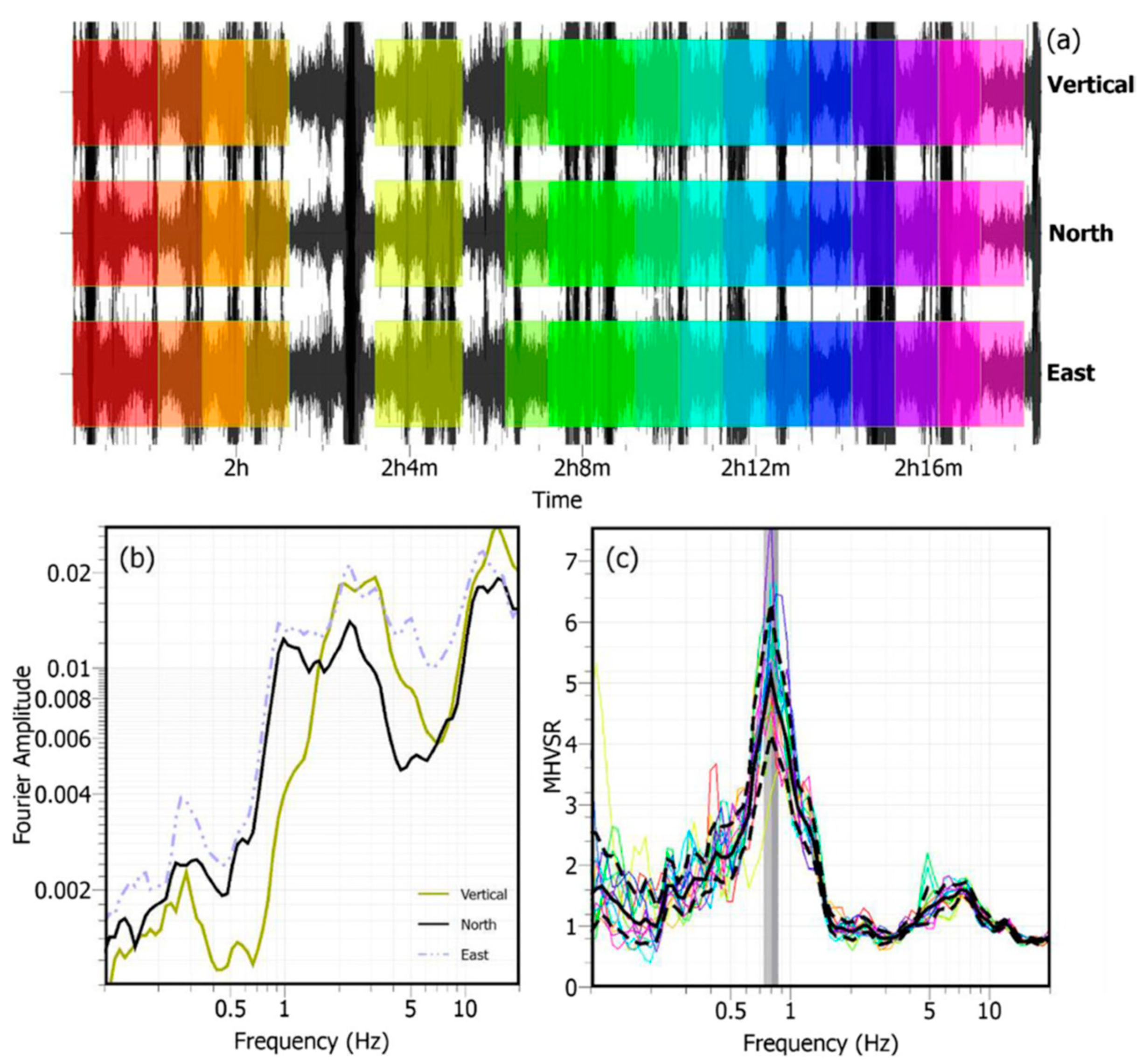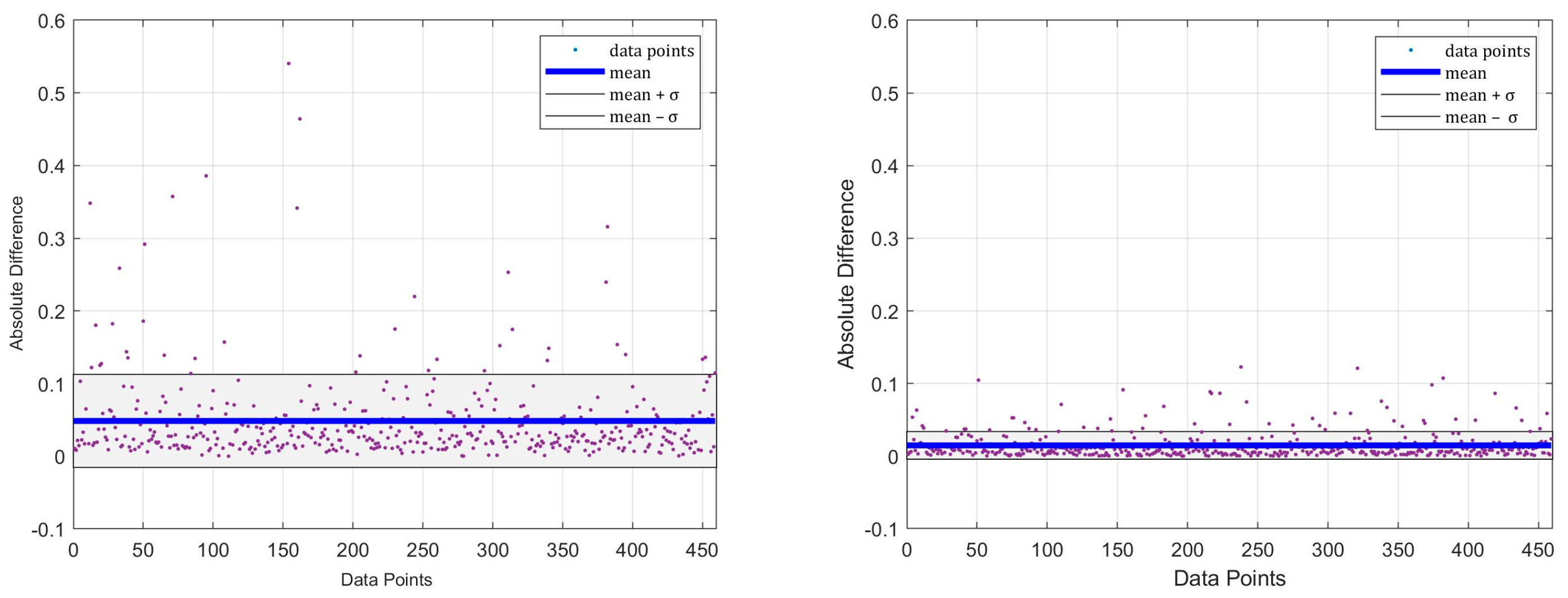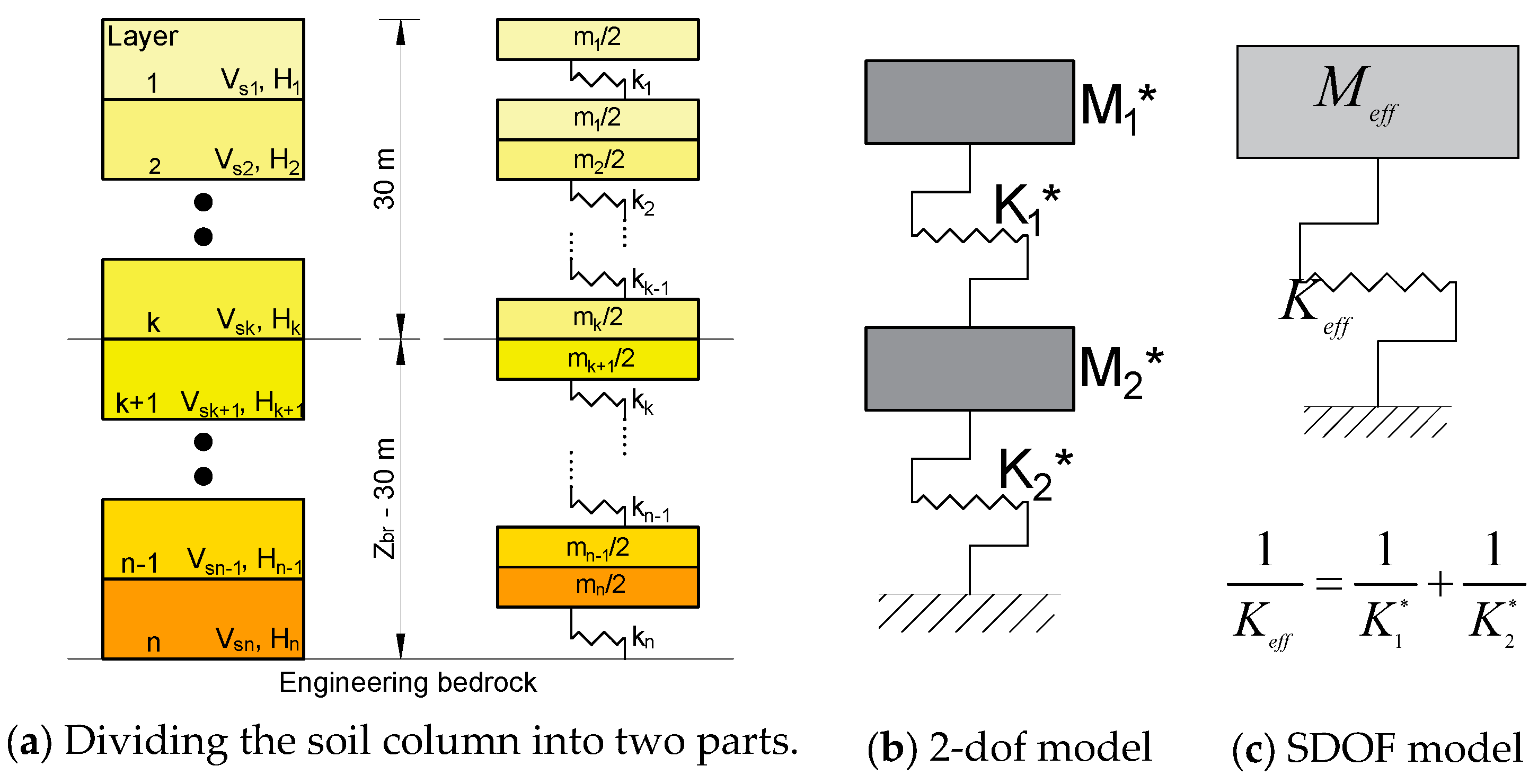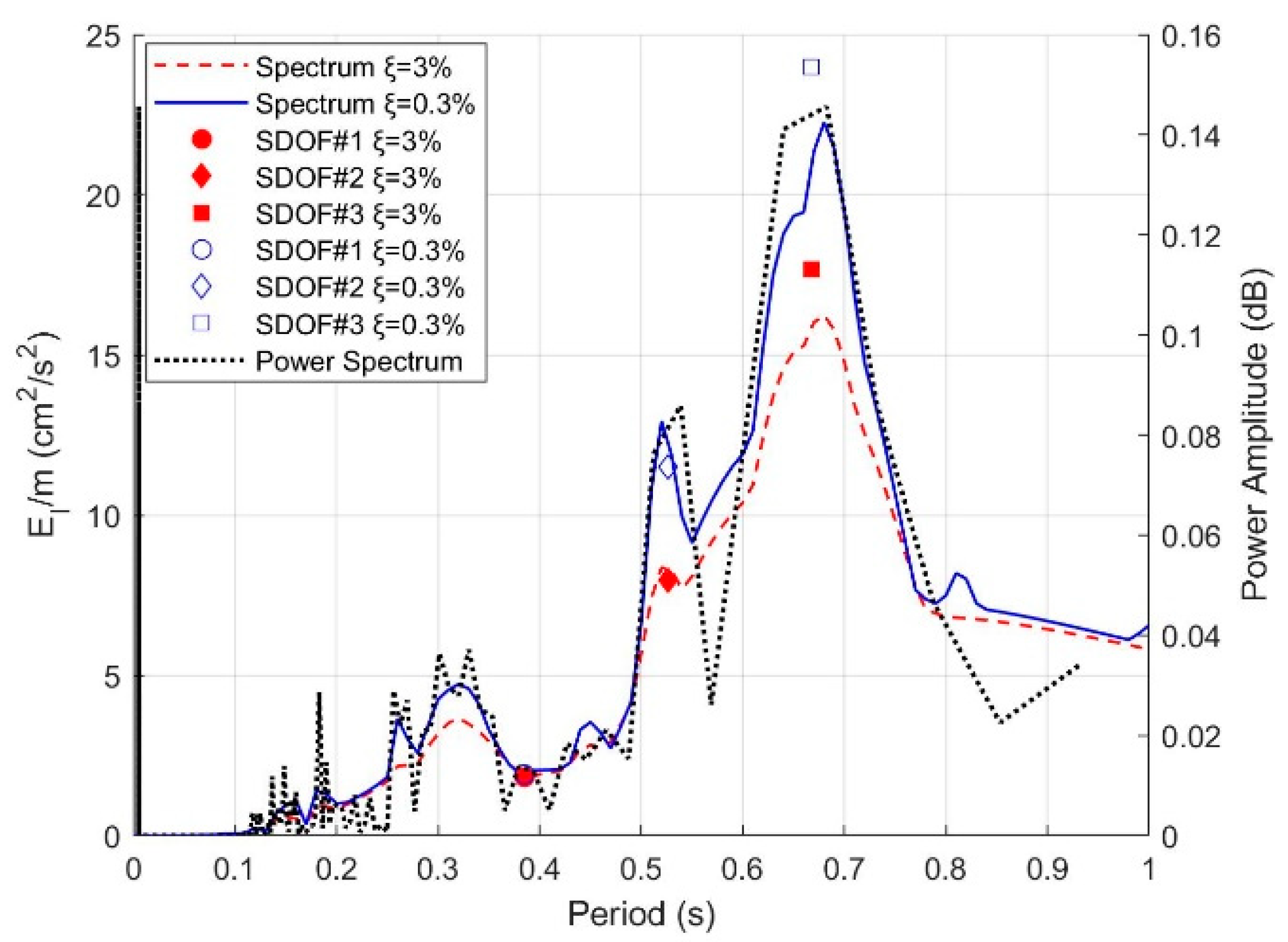A Compendious Review on the Determination of Fundamental Site Period: Methods and Importance
Abstract
:1. Introduction
2. Use of the Site’s Fundamental Period
3. Determination of the Site’s Fundamental Period
3.1. Analytical Methods
3.2. Horizontal-to-Vertical Spectral Ratio

- Method #1
- Method #2
- Method #3
3.3. Data-Driven Method
4. Discussion
5. Conclusions
Funding
Data Availability Statement
Conflicts of Interest
References
- Kitazawa, G. Damages to the wooden houses in the City of Tokyo and its suburbs. Bull. Earthq. Investig. Commun. 1926, 100, 1–126. (In Japanese) [Google Scholar]
- Kramer, S.L. Geotechnical Earthquake Engineering; Prentice Hall: Upper Saddle River, NJ, USA, 1996. [Google Scholar]
- Deniz, A.; Yüksel, E.; Çelik, O.C.; Çakır, Z.; Yaltırak, C.; Serter, E.; Yıldırım, H.; Güllü, A. 30.10.2020 Izmir Earthquake Evaluation Report; Istanbul Technical University: Istanbul, Turkey, 2020. (In Turkish) [Google Scholar]
- Beresnev, I.A.; Wen, K.L. Nonlinear soil response-A reality? Bull. Seismol. Soc. Am. 1996, 86, 1964–1978. [Google Scholar] [CrossRef]
- Borcherdt, R.D. Effects of local geology on ground motion near San Francisco Bay. Bull. Seismol. Soc. Am. 1970, 60, 29–61. [Google Scholar]
- Kagami, H.; Duke, C.M.; Liang, G.C.; Ohta, Y. Evaluation of site effect upon seismic wave amplification due to extremely deep soil deposits. Bull. Seismol. Soc. Am. 1982, 72, 987–998. [Google Scholar] [CrossRef]
- Bard, P.Y.; Bouchon, M. The seismic response of sediment-filled valleys. Part I. The case of incident SH waves. Bull. Seismol. Soc. Am. 1980, 70, 1263–1286. [Google Scholar] [CrossRef]
- Housner, G.W. Behavior of structures during earthquakes. J. Eng. Mech. Div. ASCE 1959, EM4, 109–129. [Google Scholar] [CrossRef]
- Goda, K.; Kiyota, T.; Pokhrel, R.M.; Chiaro, G.; Katagiri, T.; Sharma, K.; Wilkinson, S. The 2015 Gorkha Nepal earthquake: Insights from earthquake damage survey. Front. Built Environ. 2015, 1, 8. [Google Scholar] [CrossRef]
- Beck, J.L.; HallJ, F. Factors contributing to the catastrophe in Mexico City during the earthquake of September 19, 1985. Geophys. Res. Lett. 1986, 3, 593–596. [Google Scholar] [CrossRef]
- Kawase, H. Irregular ground analysis to interpret time-characteristics of strong motion recorded in Mexico City during 1985 Mexico earthquake. Dev. Geotech. Eng. 1987, 44, 467–476. [Google Scholar]
- Panzera, F.; Lombardo, G.; Imposa, S.; Grassi, S.; Gresta, S.; Catalano, S.; Romagnoli, G.; Tortorici, G.; Patti, F.; Di Maio, E. Correlation between earthquake damage and seismic site effect: The study case of Lentini and Carlentini, Italy. Eng. Geol. 2018, 240, 149–162. [Google Scholar] [CrossRef]
- AFAD Disaster and Emergency Management Authority of Turkey. Available online: https://deprem.afad.gov.tr/tarihteBuAy?id=25 (accessed on 27 September 2023). (In Turkish)
- Yazdi, M.; Motamed, R.; Anderson, J.G. A New Set of Automated Methodologies for Estimating Site Fundamental Frequency and Its Uncertainty Using Horizontal-to-Vertical Spectral Ratio Curves. Seismol. Res. Lett. 2022, 93, 1721–1736. [Google Scholar] [CrossRef]
- Zhu, C.; Pilz, M.; Cotton, F. Which is a better proxy, site period or depth to bedrock, in modeling linear site response in addition to the average shear-wave velocity? Bull. Earthq. Eng. 2020, 18, 797–820. [Google Scholar] [CrossRef]
- Hassani, B.; Atkinson, G.M. Applicability of the NGAwest2 site-effects model for central and eastern North America. Bull. Seismol. Soc. Am. 2016, 106, 1331–1341. [Google Scholar] [CrossRef]
- Hassani, B.; Atkinson, G.M. Applicability of the site fundamental frequency as a VS30 proxy for central and eastern North America. Bull. Seismol. Soc. Am. 2016, 106, 653–664. [Google Scholar] [CrossRef]
- Hassani, B.; Atkinson, G.M. Site-effects model for central and eastern North America based on peak frequency. Bull. Seismol. Soc. Am. 2016, 106, 2197–2213. [Google Scholar] [CrossRef]
- Zhao, J.X.; Xu, H. A comparison of VS30 and site period as site effect parameters in response spectral ground-motion prediction equations. Bull. Seismol. Soc. Am. 2013, 103, 1. [Google Scholar] [CrossRef]
- Pitilakis, K.; Riga, E.; Anastasiadis, A. New code site classification, amplification factors and normalized response spectra based on a worldwide ground-motion database. Bull. Earthq. Eng. 2013, 11, 925–966. [Google Scholar] [CrossRef]
- Hassani, B.; Atkinson, G.M. Application of a site-effects model based on peak frequency and average shear-wave velocity to California. Bull. Seismol. Soc. Am. 2018, 108, 351–357. [Google Scholar] [CrossRef]
- Luzi, L.; Puglia, R.; Pacor, F.; Gallipoli, M.; Bindi, D.; Mucciarelli, M. Proposal for a soil classification based on parameters alternative or complementary to Vs30. Bull. Earthq. Eng. 2011, 9, 1877–1898. [Google Scholar] [CrossRef]
- Wang, Y.S.; Shi, Y.; Jiang, W.P.; Yao, E.L.; Miao, Y. Estimating site fundamental period from shear-wave velocity profile. Bull. Seismol. Soc. Am. 2018, 108, 3431–3445. [Google Scholar] [CrossRef]
- Borja, R.I.; Chao, H.-Y.; Montáns, F.J.; Lin, C.-H. Nonlinear ground response at Lotung LSST site. J. Geotech. Geoenviron. Eng. 1999, 125, 187–197. [Google Scholar] [CrossRef]
- Baturay, M.B.; Stewart, J.P. Uncertainty and bias in ground-motion estimates from ground response analyses. Bull. Seismol. Soc. Am. 2003, 93, 2025–2042. [Google Scholar] [CrossRef]
- Lee, C.-P.; Tsai, Y.-B.; Wen, K.-L. Analysis of nonlinear site response using the LSST downhole accelerometer array data. Soil Dyn. Earthq. Eng. 2006, 26, 435–460. [Google Scholar] [CrossRef]
- Tsai, C.-C.; Hashash, Y.M. Learning of dynamic soil behavior from downhole arrays. J. Geotech. Geoenviron. Eng. 2009, 135, 745–757. [Google Scholar] [CrossRef]
- Thompson, E.M.; Baise, L.G.; Tanaka, Y.; Kayen, R.E. A taxonomy of site response complexity. Soil Dyn. Earthq. Eng. 2012, 41, 32–43. [Google Scholar] [CrossRef]
- Yee, E.; Stewart, J.P.; Tokimatsu, K. Elastic and large-strain nonlinear seismic site response from analysis of vertical array recordings. J. Geotech. Geoenviron. Eng. 2013, 139, 1789–1801. [Google Scholar] [CrossRef]
- Kaklamanos, J.; Baise, L.G.; Thompson, E.M.; Dorfmann, L. Comparison of 1-D linear, equivalent-linear, and nonlinear site response models at six KiK-net validation sites. Soil Dyn. Earthq. Eng. 2015, 69, 207–219. [Google Scholar] [CrossRef]
- Pinzón, L.A.; Leiva, D.A.H.; Moya-Fernández, A.; Schmidt-Díaz, V.; Pujades, L.G. Seismic site classification of the Costa Rican Strong-Motion Network based on V S30 measurements and site fundamental period. Earth Sci. Res. J. 2021, 25, 383–389. [Google Scholar] [CrossRef]
- Benjumea, B.; Hunter, J.A.; Pullan, S.E.; Brooks, G.R.; Pyne, M.; Aylsworth, J.M. VS30 and fundamental site period estimates in soft sediments of the Ottawa Valley from near-surface geophysical measurements. J. Environ. Eng. Geophys. 2008, 13, 313–323. [Google Scholar] [CrossRef]
- Laouami, N. Vertical ground motion prediction equations and vertical-to-horizontal (V/H) ratios of PGA and PSA for Algeria and surrounding region. Bull. Earthq. Eng. 2019, 17, 3637–3660. [Google Scholar] [CrossRef]
- Chousianitis, K.; Del Gaudio, V.; Pierri, P.; Tselentis, G.A. Regional ground-motion prediction equations for amplitude-, frequency response-, and duration-based parameters for Greece. Earthq. Eng. Struct. Dyn. 2018, 47, 2252–2274. [Google Scholar] [CrossRef]
- Alessandro, C.D.; Bonilla, L.F.; Boore, D.M.; Rovelli, A.; Scotti, O. Predominant-Period Site Classification for Response Spectra Prediction Equations in Italy. Bull. Seismol. Soc. Am. 2012, 102, 680–695. [Google Scholar] [CrossRef]
- Seyhan, E.; Stewart, J.P. Semi-empirical nonlinear site amplification from NGA-West2 data and simulations. Earthq. Spectra 2014, 30, 1241–1256. [Google Scholar] [CrossRef]
- Hassani, B.; Atkinson, G.M. Site-effects model for central and eastern North America based on peak frequency and average shear-wave velocity. Bull. Seismol. Soc. Am. 2018, 108, 338–350. [Google Scholar] [CrossRef]
- Yazdi, M.; Anderson, J.G.; Motamed, R. Reducing the uncertainties in the NGA-West2 ground motion models by incorporating the frequency and amplitude of the fundamental peak of the horizontal-to-vertical spectral ratio of surface ground motions. Earthq. Spectra 2023, 39, 1088–1108. [Google Scholar] [CrossRef]
- Kotha, S.R.; Cotton, F.; Bindi, D. A new approach to site classification: Mixed-effects Ground Motion Prediction Equation with spectral clustering of site amplification functions. Soil Dyn. Earthq. Eng. 2018, 110, 318–329. [Google Scholar] [CrossRef]
- Kwak, D.Y.; Seyhan, E. Two-stage nonlinear site amplification modeling for Japan with VS 30 and fundamental frequency dependency. Earthq. Spectra 2020, 36, 1359–1385. [Google Scholar] [CrossRef]
- Ambraseys, N.N. A note on the response of an elastic overburden of varying rigidity to an arbitrary ground motion. Bull. Seismol. Soc. Am. 1959, 49, 211–220. [Google Scholar] [CrossRef]
- Idriss, I.M.; Seed, H.B. Seismic response of horizontal soil layers. J. Soil Mech. Found. Div. 1968, 94, 1003–1034. [Google Scholar] [CrossRef]
- Madera, G.A. Fundamental Period and Peak Accelerations in Layered Systems; Research Report R70–37; Department of Civil Engineering, MIT: Cambridge, MA, USA, 1971. [Google Scholar]
- Hadjian, A.H. Fundamental period and mode shape of layered soil profiles. Soil Dyn. Earthq. Eng. 2002, 22, 885–891. [Google Scholar] [CrossRef]
- Dobry, R.; Oweis, I.; Urzua, A. Simplified procedures for estimating the fundamental period of a soil profile. Bull. Seismol. Soc. Am. 1976, 66, 1293–1321. [Google Scholar]
- Motazedian, D.K.; Hunter, B.J.; Sivathayalam, S.; Crow, H.; Brooks, G. Comparison of site periods derived from different evaluation methods. Bull. Seismol. Soc. Am. 2011, 101, 2492–2954. [Google Scholar] [CrossRef]
- Urzua, A.; Dobry, R.; Christian, J. Is harmonic averaging of shear wave velocity or the simplified Rayleigh method appropriate to estimate the period of a soil profile. Earthq. Spectra 2017, 33, 895–915. [Google Scholar] [CrossRef]
- Gazetas, G. Vibrational characteristics of soil deposits with variable wave velocity. Int. J. Numer. Anal. Methods Geomech. 1982, 6, 1–20. [Google Scholar] [CrossRef]
- Biggs, J.M. Introduction to Structural Dynamics; McGraw Hill: New York, NY, USA, 1964. [Google Scholar]
- Building Center of Japan (BCJ). Building Standard Law; Building Center of Japan (BCJ): Tokyo, Japan, 2005. [Google Scholar]
- Nakamura, Y. A method for dynamic characteristics estimation of subsurface using microtremor on the ground surface. Q. Rep. Railw. Tech. Res. Inst. 1989, 30, 25–33. [Google Scholar]
- Nakamura, Y. Real-time information systems for seismic hazards mitigation UrEDAS, HERAS and PIC. Q. Rep.-Rtri 1996, 37, 112–127. [Google Scholar]
- Nakamura, Y. Clear identification of fundamental idea of Nakamura’s technique and its applications. In Proceedings of the 12th World Conference on Earthquake Engineering, Auckland, New Zealand, 30 January–4 February 2000; pp. 1–8. [Google Scholar]
- Lunedei, E.; Albarello, D. Theoretical HVSR curves from full wavefield modelling of ambient vibrations in a weakly dissipative layered Earth. Geophys. J. Int. 2010, 181, 1093–1108. [Google Scholar] [CrossRef]
- Konno, K.; Ohmachi, T. Ground-motion characteristics estimated from spectral ratio between horizontal and vertical components of microtremor. Bull. Seismol. Soc. Am. 1998, 88, 228–241. [Google Scholar] [CrossRef]
- Zhu, C.; Cotton, F.; Pilz, M. Detecting site resonant frequency using HVSR: Fourier versus response spectrum and the first versus the highest peak frequency. Bull. Seismol. Soc. Am. 2020, 110, 427–440. [Google Scholar] [CrossRef]
- Kawase, H.; Mori, Y.; Nagashima, F. Difference of horizontal-to-vertical spectral ratios of observed earthquakes and microtremors and its application to S-wave velocity inversion based on the diffuse field concept. Earth Planets Space 2018, 70, 1. [Google Scholar] [CrossRef]
- Field, E.; Jacob, K. The theoretical response of sedimentary layers to ambient seismic noise. Geophys. Res. Lett. 1993, 20, 2925–2928. [Google Scholar] [CrossRef]
- Bour, M.; Fouissac, D.; Dominique, P.; Martin, C. On the use of microtremor recordings in seismic microzonation. Soil Dyn. Earthq. Eng. 1998, 17, 465–474. [Google Scholar] [CrossRef]
- Haghshenas, E.; Bard, P.Y.; Theodulidis, N. Sesame WP04 Team. Empirical evaluation of microtremor H/V spectral ratio. Bull. Earthq. Eng. 2008, 6, 75–108. [Google Scholar] [CrossRef]
- Molnar, S.; Cassidy, J.F. A comparison of site response techniques using weak-motion earthquakes and microtremors. Earthq. Spectra 2006, 22, 169–188. [Google Scholar] [CrossRef]
- Bard, P.-Y.; Acerra, C.; Aguacil, G.; Anastasiadis, A.; Atakan, K.; Azzara, R.; Basili, E.; Bertrand, B.; Bettig, B.; Blarel, F.; et al. Guidelines for the implementation of the H/V spectral ratio technique on ambient vibrations measurements, processing and interpretation. Bull. Earthq. Eng. 2008, 6, 1–2. [Google Scholar] [CrossRef]
- Kwak, Y.; Stewart, J.P.; Mandokhail, S.J.; Park, D. Supplementing VS30 with H/V spectral ratios for predicting site effects. Bull. Seismol. Soc. Am. 2017, 107, 2028–2042. [Google Scholar] [CrossRef]
- Ghofrani, H.; Atkinson, G.M.; Goda, K. Implications of the 2011 M9. 0 Tohoku Japan earthquake for the treatment of site effects in large earthquakes. Bull. Earthq. Eng. 2013, 11, 171–203. [Google Scholar] [CrossRef]
- Ghofrani, H.; Atkinson, G.M. Site condition evaluation using horizontal-to-vertical response spectral ratios of earthquakes in the NGA-West 2 and Japanese databases. Soil Dyn. Earthq. Eng. 2014, 67, 30–43. [Google Scholar] [CrossRef]
- Acerra, C.; Aguacil, G.; Anastasiadis, A.; Atakan, K.; Azzara, R.; Bard, P.Y.; Zacharopoulos, S. Guidelines for the Implementation of the H/V Spectral Ratio Technique on Ambient Vibrations Measurements, Processing and Interpretation; EVG1-CT-2000-00026 SESAME; European Commission: Brussels, Belgium, 2004; Available online: http://sesame.geopsy.org/Delivrables/Del-D23-HV_User_Guidelines.pdf (accessed on 27 September 2023).
- Bard, P.Y. The H/V technique: Capabilities and limitations based on the results of the SESAME project. Bull. Earthq. Eng. 2008, 6, 1–2. [Google Scholar] [CrossRef]
- Vantassel, J.; Cox, B.; Wotherspoon, L.; Stolte, A. Mapping depth to bedrock, shear stiffness, and fundamental site period at CentrePort, Wellington, using surface-wave methods: Implications for local seismic site amplification. Bull. Seismol. Soc. Am. 2018, 108, 1709–1721. [Google Scholar] [CrossRef]
- Özalaybey, S.; Zor, E.; Ergintav, S.; Tapırdamaz, M.C. Investigation of 3-D basin structures in the Izmit Bay area (Turkey) by single-station microtremor and gravimetric methods. Geophys. J. Int. 2011, 186, 883–894. [Google Scholar] [CrossRef]
- Eskişar, T.; Özyalin, Ş.; Kuruoǧlu, M.; Yilmaz, H.R. Microtremor measurements in the northern coast of Izmir Bay, Turkey to evaluate site-specific characteristics and fundamental periods by H/V spectral ratio method. J. Earth Syst. Sci. 2013, 122, 123–136. [Google Scholar] [CrossRef]
- Pilz, M.; Parolai, S.; Leyton, F.; Campos, J.; Zschau, J. A comparison of site response techniques using earthquake data and ambient seismic noise analysis in the large urban areas of Santiago de Chile. Geophys. J. Int. 2009, 178, 713–728. [Google Scholar] [CrossRef]
- Leyton, F.; Ruiz, S.; Sepúlveda, S.A.; Contreras, J.P.; Rebolledo, S.; Astroza, M. Microtremors’ HVSR and its correlation with surface geology and damage observed after the 2010 Maule earthquake (Mw 8.8) at Talca and Curicó, Central Chile. Eng. Geol. 2013, 161, 26–33. [Google Scholar] [CrossRef]
- Stephenson, W.J.; Asten, M.W.; Odum, J.K.; Frankel, A.D. Shear-wave velocity in the Seattle Basin to 2 km depth characterized with the krSPAC microtremor array method: Insights for urban basin-scale imaging. Seismol. Res. Lett. 2019, 90, 1230–1242. [Google Scholar] [CrossRef]
- Teague, D.P.; Cox, B.R.; Rathje, E.M. Measured vs. predicted site response at the Garner Valley Downhole Array considering shear wave velocity uncertainty from borehole and surface wave methods. Soil Dyn. Earthq. Eng. 2018, 113, 339–355. [Google Scholar] [CrossRef]
- Molnar, S.; Sirohey, A.; Assaf, J.; Bard, P.Y.; Castellaro, S.; Cornou, C.; Cox, B.; Guillier, B.; Hassani, B.; Kawase, H. A review of the microtremor horizontal-to-vertical spectral ratio (MHVSR) method. J. Seismol. 2022, 26, 653–685. [Google Scholar] [CrossRef]
- Herak, M. ModelHVSR—A Matlab® tool to model horizontal-to-vertical spectral ratio of ambient noise. Comput. Geosci. 2008, 34, 1514–1526. [Google Scholar] [CrossRef]
- Kawase, H.; Sánchez-Sesma, F.J.; Matsushima, S. The optimal use of horizontal-to-vertical spectral ratios of earthquake motions for velocity inversions based on diffuse-field theory for plane waves. Bull. Seismol. Soc. Am. 2011, 101, 2001–2014. [Google Scholar] [CrossRef]
- Nagashima, F.; Matsushima, S.; Kawase, H.; Sánchez-Sesma, F.J.; Hayakawa, T.; Satoh, T.; Oshima, M. Application of horizontal-to-vertical spectral ratios of earthquake ground motions to identify subsurface structures at and around the K-NET site in Tohoku, Japan. Bull. Seismol. Soc. Am. 2014, 104, 2288–2302. [Google Scholar] [CrossRef]
- Kawase, H.; Matsushima, S.; Satoh, T.; Sánchez-Sesma, F.J. Applicability of theoretical horizontal-to-vertical ratio of microtremors based on the diffuse field concept to previously observed data. Bull. Seismol. Soc. Am. 2015, 105, 3092–3103. [Google Scholar] [CrossRef]
- Sánchez-Sesma, F.J.; Rodríguez, M.; Iturrarán-Viveros, U.; Luzón, F.; Campillo, M.; Margerin, L.; García-Jerez, A.; Suarez, M.; Santoyo, M.A.; Rodríguez-Castellanos, A. A theory for microtremor H/V spectral ratio: Application for a layered medium. Geophys. J. Int. 2011, 186, 221–225. [Google Scholar] [CrossRef]
- Arai, H.; Tokimatsu, K. S-wave velocity profiling by inversion of microtremor H/V spectrum. Bull. Seismol. Soc. Am. 2004, 94, 53–63. [Google Scholar] [CrossRef]
- Spica, Z.; Caudron, C.; Perton, M.; Lecocq, T.; Camelbeeck, T.; Legrand, D.; Piña-Flores, J.; Iglesias, A.; Syahbana, D.K. Velocity models and site effects at Kawah Ijen volcano and Ijen caldera (Indonesia) determined from ambient noise cross-correlations and directional energy density spectral ratios. J. Volcanol. Geotherm. Res. 2015, 302, 173–189. [Google Scholar] [CrossRef]
- Spica, Z.J.; Perton, M.; Nakata, N.; Liu, X.; Beroza, G.C. Site characterization at Groningen gas field area through joint surface-borehole H/V analysis. Geophys. J. Int. 2018, 212, 412–421. [Google Scholar] [CrossRef]
- Spica, Z.; Perton, M.; Nakata, N.; Liu, X.; Beroza, G.C. Shallow VS imaging of the Groningen area from joint inversion of multimode surface waves and H/V spectral ratios. Seismol. Res. Lett. 2018, 89, 1720–1729. [Google Scholar] [CrossRef]
- Tuan, T.T.; Vinh, P.C.; Ohrnberger, M.; Malischewsky, P.; Aoudia, A. An improved formula of fundamental resonance frequency of a layered half-space model used in H/V ratio technique. Pure Appl. Geophys. 2016, 173, 2803–2812. [Google Scholar] [CrossRef]
- Darzi, A.; Pilz, M.; Zolfaghari, M.R.; Fäh, D. An automatic procedure to determine the fundamental site resonance: Application to the Iranian strong motion network. Pure Appl. Geophys. 2019, 176, 3509–3531. [Google Scholar] [CrossRef]
- Cheng, T.; Hallal, M.M.; Vantassel, J.P.; Cox, B.R. Estimating unbiased statistics for fundamental site frequency using spatially distributed HVSR measurements and Voronoi tessellation. J. Geotech. Geoenviron. Eng. 2021, 147, 04021068. [Google Scholar] [CrossRef]
- Hassani, B.; Yong, A.; Atkinson, G.M.; Feng, T.; Meng, L. Comparison of site dominant frequency from earthquake and microseismic data in California. Bull. Seismol. Soc. Am. 2019, 109, 1034–1040. [Google Scholar] [CrossRef]
- Yong, A.; Ngashima, F.; Ito, E.; Kawase, H.; Fletcher, J.B.; Hayashi, K.; Martin, A.J.; Grant, A. Comparison of VS30 and f0 values from single station earthquake-to-microtremor ratio (EMR) and multi-station array-based site characterization methods. In Proceedings of the AGU Fall Meeting Abstracts, Online, 7–11 December 2020; p. S002-0006. [Google Scholar]
- Ito, E.; Cornou, C.; Nagashima, F.; Kawase, H. Estimation of velocity structures in the Grenoble Basin, France, using pseudo earthquake horizontal-to-vertical spectral ratio from microtremors. Bull. Seismol. Soc. Am. 2021, 111, 627–653. [Google Scholar] [CrossRef]
- Kawase, H.; Nagashima, F.; Ito, E.; Cornou, C. S-Wave Velocity Inversion Based on Microtremor HVR: Effectiveness of the EMR Correction for the Grenoble Basin. In Earthquake Geotechnical Engineering for Protection and Development of Environment and Constructions; CRC Press: Boca Raton, FL, USA, 2019; pp. 3250–3258. [Google Scholar]
- Lermo, J.; Chávez-García, F.J. Site effect evaluation using spectral ratios with only one station. Bull. Seismol. Soc. Am. 1993, 83, 1574–1594. [Google Scholar] [CrossRef]
- Parolai, S.; Bindi, D.; Augliera, P. Application of the generalized inversion technique (GIT) to a microzonation study: Numerical simulations and comparison with different site-estimation techniques. Bull. Seismol. Soc. Am. 2000, 90, 286–297. [Google Scholar] [CrossRef]
- Raptakis, D.; Chávez-Garcıa, F.J.; Makra, K.; Pitilakis, K. Site effects at Euroseistest—I. Determination of the valley structure and confrontation of observations with 1D analysis. Soil Dyn. Earthq. Eng. 2000, 19, 1–22. [Google Scholar] [CrossRef]
- Rong, M.; Li, H.; Yu, Y. The difference between horizontal-to-vertical spectra ratio and empirical transfer function as revealed by vertical arrays. PLoS ONE 2019, 14, e0210852. [Google Scholar] [CrossRef]
- Cadet, H.; Bard, P.-Y.; Duval, A.M.; Bertrand, E. Site effect assessment using KiK-net data: Part 2—Site amplification prediction equation based on f0 and Vsz. Bull. Earthq. Eng. 2012, 10, 451–489. [Google Scholar] [CrossRef]
- Kokusho, T.; Sato, K. Surface-to-base amplification evaluated from KiK-net vertical array strong motion records. Soil Dyn. Earthq. Eng. 2008, 28, 707–716. [Google Scholar] [CrossRef]
- Régnier, J.; Bonilla, L.F.; Bertrand, E.; Semblat, J.F. Influence of the VS profiles beyond 30 m depth on linear site effects: Assessment from the KiK-net data. Bull. Seismol. Soc. Am. 2014, 104, 2337–2348. [Google Scholar] [CrossRef]
- Régnier, J.; Cadet, H.; Bonilla, L.F.; Bertrand, E.; Semblat, J.F. Assessing nonlinear behavior of soils in seismic site response: Statistical analysis on KiK-net strong-motion data. Bull. Seismol. Soc. Am. 2013, 103, 1750–1770. [Google Scholar] [CrossRef]
- Han, B.; Yang, Z.; Zdravkovic, L.; Kontoe, S. Non-linearity of gravelly soils under seismic compressional deformation based on KiK-net downhole array observations. Geotech. Lett. 2015, 5, 287–293. [Google Scholar] [CrossRef]
- Kaklamanos, J.; Bradley, B.A.; Thompson, E.M.; Baise, L.G. Critical parameters affecting bias and variability in site-response analyses using KiK-net downhole array data. Bull. Seismol. Soc. Am. 2013, 103, 1733–1749. [Google Scholar] [CrossRef]
- Mousavi Anzehaee, M.; Heydarzadeh, K.; Adib, A. Employing the Bayesian data fusion to estimate the fundamental frequency of site by means of microtremor data. Acta Geod. Geophys. 2018, 53, 523–541. [Google Scholar] [CrossRef]
- Zhu, C.; Weatherill, G.; Cotton, F.; Pilz, M.; Kwak, D.Y.; Kawase, H. An open-source site database of strong-motion stations in Japan: K-NET and KiK-net (v1. 0.0). Earthq. Spectra 2021, 37, 2126–2149. [Google Scholar] [CrossRef]
- Zhu, C.; Cotton, F.; Kawase, H.; Haendel, A.; Pilz, M.; Nakano, K. How well can we predict earthquake site response so far? Site-specific approaches. Earthq. Spectra 2022, 38, 1047–1075. [Google Scholar] [CrossRef]
- Zhu, C.; Cotton, F.; Kawase, H.; Nakano, K. How well can we predict earthquake site response so far? Machine learning vs physics-based modeling. Earthq. Spectra 2023, 39, 478–504. [Google Scholar] [CrossRef]
- Güllü, A.; Hasanoğlu, S. A statistical investigation to determine dominant frequency of layered soil profiles. Turk. J. Eng. 2022, 6, 95–105. [Google Scholar] [CrossRef]
- Güllü, A.; Hasanoğlu, S.; Yüksel, E. A Practical Methodology to Estimate Site Fundamental Periods Based on the KiK-net Borehole Velocity Profiles and Its Application to Istanbul. Bull. Seismol. Soc. Am. 2022, 112, 2606–2620. [Google Scholar] [CrossRef]
- Güllü, A.; Yüksel, E.; Yalçın, C.; Anıl Dindar, A.; Özkaynak, H.; Büyüköztürk, O. An improved input energy spectrum verified by the shake table tests. Earthq. Eng. Struct. Dyn. 2019, 48, 27–45. [Google Scholar] [CrossRef]
- Güllü, A.; Yüksel, E.; Yalcin, C.; Buyukozturk, O. Damping effect on seismic input energy and its verification by shake table tests. Adv. Struct. Eng. 2021, 24, 2669–2683. [Google Scholar] [CrossRef]
- Hasanoğlu, S.; Güllü, E.; Güllü, A. Empirical correlations of constant ductility seismic input and hysteretic energies with conventional intensity measures. Bull. Earthq. Eng. 2023, 21, 4905–4922. [Google Scholar] [CrossRef]



Disclaimer/Publisher’s Note: The statements, opinions and data contained in all publications are solely those of the individual author(s) and contributor(s) and not of MDPI and/or the editor(s). MDPI and/or the editor(s) disclaim responsibility for any injury to people or property resulting from any ideas, methods, instructions or products referred to in the content. |
© 2023 by the author. Licensee MDPI, Basel, Switzerland. This article is an open access article distributed under the terms and conditions of the Creative Commons Attribution (CC BY) license (https://creativecommons.org/licenses/by/4.0/).
Share and Cite
Güllü, A. A Compendious Review on the Determination of Fundamental Site Period: Methods and Importance. Geotechnics 2023, 3, 1309-1323. https://doi.org/10.3390/geotechnics3040071
Güllü A. A Compendious Review on the Determination of Fundamental Site Period: Methods and Importance. Geotechnics. 2023; 3(4):1309-1323. https://doi.org/10.3390/geotechnics3040071
Chicago/Turabian StyleGüllü, Ahmet. 2023. "A Compendious Review on the Determination of Fundamental Site Period: Methods and Importance" Geotechnics 3, no. 4: 1309-1323. https://doi.org/10.3390/geotechnics3040071
APA StyleGüllü, A. (2023). A Compendious Review on the Determination of Fundamental Site Period: Methods and Importance. Geotechnics, 3(4), 1309-1323. https://doi.org/10.3390/geotechnics3040071






